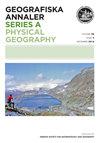冰岛东南部Hoffellsjökull冰川陆地系统:由冰瓣和冰床形态驱动的温带活动冰川退缩的地貌特征对比
IF 1.8
4区 地球科学
Q3 GEOGRAPHY, PHYSICAL
Geografiska Annaler Series A-Physical Geography
Pub Date : 2019-07-03
DOI:10.1080/04353676.2019.1631608
引用次数: 9
摘要
摘要利用冰岛东南部Hoffellsjökull前陆1:14 500比例比冰川地貌图和地表地质图,评价了一个出入口冰川内两个独立流瓣冰川-气候相互作用对比的冰川陆地系统特征。这为利用冰川地貌特征作为古代消冰地形的古气候指标提供了一个有价值的现代模拟。冰川的两个流瓣Svínafellsjökull和Hoffellsjökull的陆地系统特征明显不同。Svínafellsjökull显示插入和季节性气候调整的推动冰碛序列和冰川下流线型表面,典型的温带活动冰川位于倾斜的山前前地。Hoffellsjökull显示了典型的冲水头/沉积过深情景的地貌-沉积物组合,在此基础上,紧密间隔的复合推动冰碛反映了2000年之前小冰期高峰期及其附近的长期准静止的鼻部。Svínafellsjökull前陆的冰碛间距反映了20世纪50年代中期至60年代中期和1975年至2000年期间的年度衰退的总体趋势,由两个紧密间隔和部分重叠的锯齿状冰碛和发夹状冰碛组成的弧形带记录。这里的冰碛分布格局也反映了冰碛形成过程的时空变化,这些变化是由前冰期排水特征和结构冰川学或裂缝结构的变化共同决定的。Svínafellsjökull前陆的冰下足迹包含值得未来研究关注的特征,包括可能指示全新世区域冰进的覆盖冰碛弓形带,突出的凹槽和碎屑条纹可能分别指示槽耕和点源基岩采掘,以及相对较大的鼓点。本文章由计算机程序翻译,如有差异,请以英文原文为准。
The glacial landsystem of Hoffellsjökull, SE Iceland: contrasting geomorphological signatures of active temperate glacier recession driven by ice lobe and bed morphology
ABSTRACT A 1:14 500 scale glacial geomorphology and surficial geology map of the foreland of Hoffellsjökull, southeast Iceland is used to assess the glacial landsystem signature of the contrasting glacier-climate interactions of two separate flow lobes within one outlet glacier. This constitutes a valuable modern analogue for employing glacial geomorphological signatures as palaeoclimate indicators in ancient deglaciated terrains. The landsystem signatures of the glacier’s two flow lobes, Svínafellsjökull and Hoffellsjökull, are distinctly different. Svínafellsjökull displays inset and seasonally climatically-tuned push moraine sequences and subglacially streamlined surfaces typical of active temperate glaciers on sloping piedmont forelands. Hoffellsjökull displays the landform-sediment assemblages typical of outwash-head/depositional overdeepening scenarios, upon which closely-spaced composite push moraines reflect a long term quasi-stationary snout at and near the Little Ice Age maximum prior to 2000. Moraine spacing on the Svínafellsjökull foreland reflects an overall trend of annual recession punctuated by quasi-stability and/or readvance in the mid-1950s-1960 and 1975–2000 as recorded by two arcuate zones of closely-spaced and partially overprinted sawtooth and hairpin moraines. The pattern of moraine distribution here also reflects spatio-temporal changes in moraine-forming processes as dictated by changes in a combination of proglacial drainage characteristics and structural glaciology or crevasse architecture. The subglacial footprint of the Svínafellsjökull foreland contains features worthy of future research attention, including an arcuate zone of overridden moraines potentially indicative of a regional Holocene ice advance, prominent flutings and debris stripes potentially indicative of groove-ploughing and point-source bedrock plucking respectively, and relatively large drumlins.
求助全文
通过发布文献求助,成功后即可免费获取论文全文。
去求助
来源期刊
CiteScore
3.60
自引率
0.00%
发文量
12
审稿时长
>12 weeks
期刊介绍:
Geografiska Annaler: Series A, Physical Geography publishes original research in the field of Physical Geography with special emphasis on cold regions/high latitude, high altitude processes, landforms and environmental change, past, present and future.
The journal primarily promotes dissemination of regular research by publishing research-based articles. The journal also publishes thematic issues where collections of articles around a specific themes are gathered. Such themes are determined by the Editors upon request. Finally the journal wishes to promote knowledge and understanding of topics in Physical Geography, their origin, development and current standing through invited review articles.

 求助内容:
求助内容: 应助结果提醒方式:
应助结果提醒方式:


